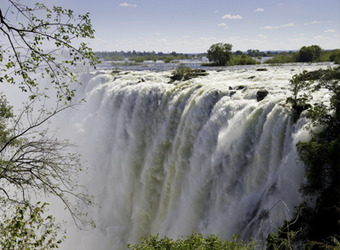Victoria Falls (Zambia side)
Click here to be the first to review Victoria Falls (Zambia side)
Start Planning Your Custom Safari view larger image
view larger image
You'll see the spray first, visible for miles, called Mosi-oa-Tunya – the “smoke that thunders” – by the local people. The roar of the cataract follows, as the Zambezi River plunges 350 feet over a basalt cliff into the gorge below. View Victoria Falls on rainforest trails, from the famous bridge, or via an exhilarating helicopter or ultralight flight – activities abound in Livingstone, including whitewater rafting, canoeing and sunset cruises.
 view image gallery
view image gallery
The Safari Experience
The Victoria Falls boasts the largest curtain of water of any waterfall in the world, at over 5,600 feet wide and 350 feet deep. The cloud of spray above this thundering mass of water sustains a small rainforest at the edge of the gorge, supporting a large number of herbaceous and shrub species. Tour the falls, enjoy wildlife drives in Mosi-oa-Tunya National Park, visit town museums and markets, encounter lovely personalities at a local village, bungee jump, soar above the falls by helicopter or microlight, raft, or enjoy a fishing excursion or sunset cruise on the Zambezi River. When the waters are lower, typically August through December, a speedboat can whisk you to Livingstone Island at the very edge of the falls for an al fresco breakfast, lunch or afternoon tea. The island is famous for its “Devil’s Pool” offering an exhilarating, after-lunch swim as the water gently dribbles over the edge into the gorge below.
 view image gallery
view image gallery
Wildlife
Bushbuck, banded mongoose, vervet monkey and baboon dart through the lush forest of ebony, mahogany, fig and milkwood trees at the lip of the falls. More extensive wildlife exploration can be enjoyed by open, 4x4 vehicles in the Mosi-oa-Tunya Zoological Park, the only place to see rhino in Zambia. It’s likely to see elephant and buffalo as well, and occasionally lion. Because the area is cushioned by several protected areas, wildlife has been able to thrive here, even with the bustle of Livingstone town nearby. Trumpeter hornbills soar overhead, and the Schalow’s turaco may be recognized by its fiery, red wingspan. Nile crocodile and hippo can be seen, and often heard, upstream from the falls, from the decks of the lovely hotels and lodges dotting the banks of the Zambezi River. Fishing is a great way to experience the many different fish, with 84 different species recorded above the falls.
 view image gallery
view image gallery
How to Include Victoria Falls in Your Safari Itinerary
Recommended Number of Nights
Nature Travelers: 1-2 nights
Photographers: 1-2 nights
Families: 2 nights
Active Travelers: 2 nights
Other Regions to Include
Victoria Falls seems to “fasten” Botswana, Zambia and Zimbabwe together. Within Zambia, a circuit including the South Luangwa, Lower Zambezi and Kafue national parks showcases floodplains, river systems, varied woodlands and the falls itself, with opportunities to see such a diverse range of animals and subspecies found nowhere else, particularly in the Luangwa Valley, or tree-climbing lions in Kafue and Lower Zambezi. Linking the famous Okavango Delta, Kalahari and Linyanti regions with Victoria Falls is a given for most Botswana safaris. Since Victoria Falls straddles the borders of Zambia and Zimbabwe, visiting Hwange and Mana Pools national parks is easy and offers a different or complementary experience to the parks in Zambia. Hwange is known for its herds of elephant and buffalo. In seasonal Mana Pools it’s common to see elephant standing up on their hind legs to reach tree fruit. Victoria Falls is often combined with the iconic Cape Town and Sabi Sand regions of South Africa for a well-rounded safari.
